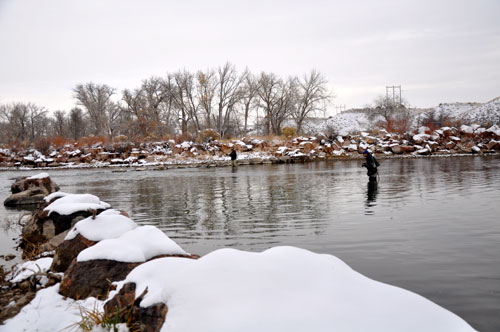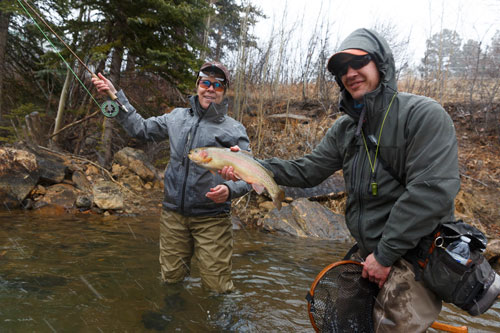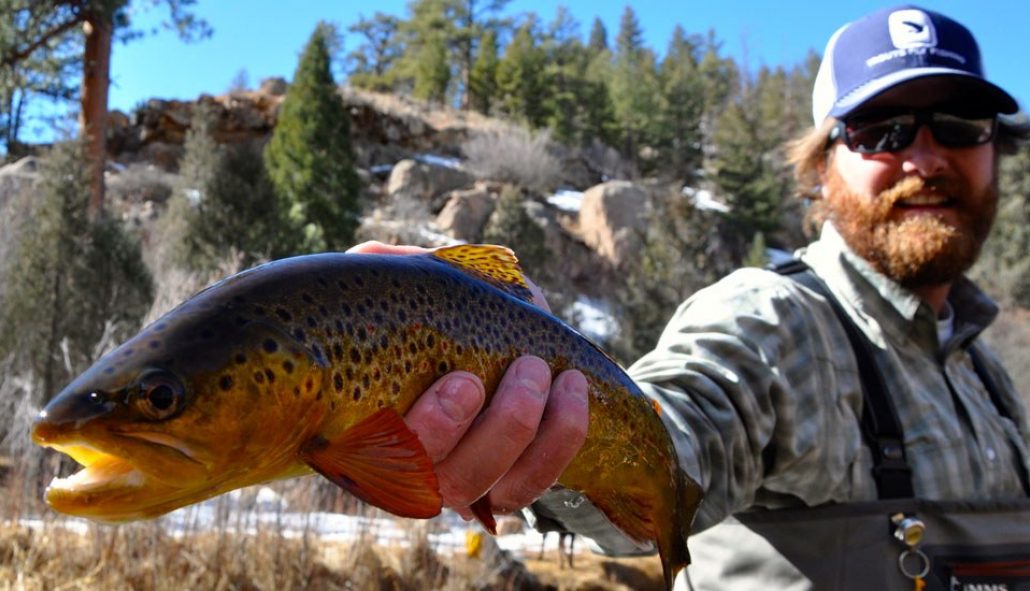Welcome to Part 3 of our 3 part series devoted to fly fishing for trout in the Winter.
 In the past two installments we’ve discussed A) What Happens To A Trout During Winter and B) Flies and Food Sources for Winter Trout. If you happened to miss these first two discussions, click the links to get caught up. While these are both very important topics to consider, they don’t mean much if we don’t also discuss the final piece of the puzzle- Presentation and Reading Water. After all, an understanding of Winter trout behavior, along with using the proper flies don’t equate to fish in the net if we’re not fishing in the correct places. We’ll break this final topic down into three categories- Presentation (which includes rigging), Reading Water, and end with a few final thoughts.
In the past two installments we’ve discussed A) What Happens To A Trout During Winter and B) Flies and Food Sources for Winter Trout. If you happened to miss these first two discussions, click the links to get caught up. While these are both very important topics to consider, they don’t mean much if we don’t also discuss the final piece of the puzzle- Presentation and Reading Water. After all, an understanding of Winter trout behavior, along with using the proper flies don’t equate to fish in the net if we’re not fishing in the correct places. We’ll break this final topic down into three categories- Presentation (which includes rigging), Reading Water, and end with a few final thoughts.
For presentation and rigging, two thoughts need to be in your mind- 1) Be Thorough 2) Get Down To The Fish.
Regarding thought number 1- remember the shoebox analogy I’ve used in the past? This is where it gets put to use. Imagine what it would look like to put a trout in a shoebox. Not much room on either side huh? This is a good visual to apply to a trouts feeding zone this time of year. Your goal needs to be to get your flies in this tight of a zone if you want to get consistent eats. While a fish may move a foot or more for your fies in the Summer, don’t plan on this being the case during Winter. If you’re fishing an area you feel confident holds fish, be extremely thorough in your presentation. I like to think of the hole I’m fishing with a grid of 1 foot X 1 foot squares being laid across the surface. Your goal should be to pick the pool/hole apart this thoroughly. Having a plan to pick apart a hole is crucial for many reasons. A) it let’s you know when you’ve worked it thoroughly and perhaps its time to move on. And B) It will make you’re fishing WAY more efficient than just haphazardly running a bunch of drifts through the hole. Really concentrate on dissecting your chosen fishing location, and I guarantee it will lead to more catches.
 For thought number 2)- Getting down to the fish is just as important (and probably more) than where you’re fishing. Remember, the fish are sitting TIGHT to the bottom this time of year. Sometimes with their bellies actually touching the bottom. Getting down to their feeding zone will more than likely involve A) more distance between flies and indicator B) more weight than you think is necessary and C) repeatedly cleaning off your flies throughout the day. I’ve talked about the indicator depth/weight topic countless topics and guess what…I’m not stopping anytime soon. It's just that imperative to do correctly. Remember, it’s always best too err on the side of too deep and too much weight to start, and then slowly back off each until you find yourself ticking the river bottom consistently without getting hung up every drift. My biggest key to know when my depth/weight is inline (aside from regular bottom ticks) is that my indicator will be floating SLOWER than the bubbles on the surface. If you’ve never focused on your indicator speed vs. bubble speed before, do so next time out. You’ll instantly see what I mean.
For thought number 2)- Getting down to the fish is just as important (and probably more) than where you’re fishing. Remember, the fish are sitting TIGHT to the bottom this time of year. Sometimes with their bellies actually touching the bottom. Getting down to their feeding zone will more than likely involve A) more distance between flies and indicator B) more weight than you think is necessary and C) repeatedly cleaning off your flies throughout the day. I’ve talked about the indicator depth/weight topic countless topics and guess what…I’m not stopping anytime soon. It's just that imperative to do correctly. Remember, it’s always best too err on the side of too deep and too much weight to start, and then slowly back off each until you find yourself ticking the river bottom consistently without getting hung up every drift. My biggest key to know when my depth/weight is inline (aside from regular bottom ticks) is that my indicator will be floating SLOWER than the bubbles on the surface. If you’ve never focused on your indicator speed vs. bubble speed before, do so next time out. You’ll instantly see what I mean.
Moving on to reading water, keep in mind that your goal is not to ‘find fish’- that’s easy and involves simply looking for the deep, slow moving holes. Rather, your goal is to find ‘feeding fish’. While dredging the deep pools can certainly produce a few fish, your most consistent place for hooking up will be the perimeter edges of these deep ‘wintering holes’. Throughout parts of the day (usually warmer, midday), fish that pull up into these warmer, shallower areas are there for one reason- to feed. While these ‘shallower’ zones –often 1-3 foot deep- won’t hold as many fish. They are holding the right fish- feeding fish. As you approach a zone you suspect to hold fish, always make sure your first drifts are around the shallower perimeter of the deep portion of the hole. Additionally, if the sun is out, make sure spend a minute (or five) looking for fish before you start casting. You’ll be surprised how shallow winter fish will sometimes get when they’re in a good mood, the sun has warmed the water a degree or two, and there’s a few midges/baetis coming off. When focusing on these perimeter edges, look for what I call “walking speed water” (which is literally just what it sounds like, water moving at the speed of a casual stroll) and put your attention on these zones. Eddies, Shelves, and Tailouts are all great places to find this speed of water.
Lastly, there are a few final thoughts I’d like to leave with you.
 1. Hooksets are free so set often! Winter trout won’t typically attack your fly, but rather gently take it. Any quiver, pause, hesitation of the indicator should result in a hookset. Don’t look for the classic “summer dunk” where your indicator jumps six inches below the surface.
1. Hooksets are free so set often! Winter trout won’t typically attack your fly, but rather gently take it. Any quiver, pause, hesitation of the indicator should result in a hookset. Don’t look for the classic “summer dunk” where your indicator jumps six inches below the surface.
2. Bundle Up and Eat- If even 1% of you is thinking about being cold or hungry, you’re not 100% thinking about fishing.
3. Stalk softly and watch your shadows- remember, even though it’s Wintertime, feeding fish will often pull up quite shallow (particularly on the South Platte). Wade quietly and avoid throwing your shadow (which will be longer this time of year with the low sun) over shallow feeding fish.
4. Short drifts and high stick- this ties into properly picking apart a run (remember the grid). Making long casts with lots of mends will never be the most effective way to really pick apart a run. Shorts drifts with lots of weight while using a high-stick nymphing method should be your goal.
As I look outside at the snow blowing, fishing is still on my mind and should be on yours too. Remember, fish have to eat for a living and are still very catchable as long as a few minor adjustments are made!
If you’d like to discuss Winter fishing in further detail please let us know. Also, remember to mark your calendars for Thursday, January 22nd! I’ll be giving an in-store presentation, titled “A Guide’s Guide To Fishing The South Platte During Winter”. This world-famous presentation (okay maybe not, but it's good to have goals) will review all of this information in greater detail and have plenty of time for Q&A!
New to fly-fishing? We’ll be kicking off our Learn The Basics classes for 2015 on Wednesday, January 14th. Click the link to learn more!


 In the past two installments we’ve discussed A)
In the past two installments we’ve discussed A)  For thought number 2)- Getting down to the fish is just as important (and probably more) than where you’re fishing. Remember, the fish are sitting TIGHT to the bottom this time of year. Sometimes with their bellies actually touching the bottom. Getting down to their feeding zone will more than likely involve A) more distance between flies and indicator B) more weight than you think is necessary and C) repeatedly cleaning off your flies throughout the day. I’ve talked about the indicator depth/weight topic countless topics and guess what…I’m not stopping anytime soon. It's just that imperative to do correctly. Remember, it’s always best too err on the side of too deep and too much weight to start, and then slowly back off each until you find yourself ticking the river bottom consistently without getting hung up every drift. My biggest key to know when my depth/weight is inline (aside from regular bottom ticks) is that my indicator will be floating SLOWER than the bubbles on the surface. If you’ve never focused on your indicator speed vs. bubble speed before, do so next time out. You’ll instantly see what I mean.
For thought number 2)- Getting down to the fish is just as important (and probably more) than where you’re fishing. Remember, the fish are sitting TIGHT to the bottom this time of year. Sometimes with their bellies actually touching the bottom. Getting down to their feeding zone will more than likely involve A) more distance between flies and indicator B) more weight than you think is necessary and C) repeatedly cleaning off your flies throughout the day. I’ve talked about the indicator depth/weight topic countless topics and guess what…I’m not stopping anytime soon. It's just that imperative to do correctly. Remember, it’s always best too err on the side of too deep and too much weight to start, and then slowly back off each until you find yourself ticking the river bottom consistently without getting hung up every drift. My biggest key to know when my depth/weight is inline (aside from regular bottom ticks) is that my indicator will be floating SLOWER than the bubbles on the surface. If you’ve never focused on your indicator speed vs. bubble speed before, do so next time out. You’ll instantly see what I mean. 1. Hooksets are free so set often! Winter trout won’t typically attack your fly, but rather gently take it. Any quiver, pause, hesitation of the indicator should result in a hookset. Don’t look for the classic “summer dunk” where your indicator jumps six inches below the surface.
1. Hooksets are free so set often! Winter trout won’t typically attack your fly, but rather gently take it. Any quiver, pause, hesitation of the indicator should result in a hookset. Don’t look for the classic “summer dunk” where your indicator jumps six inches below the surface.